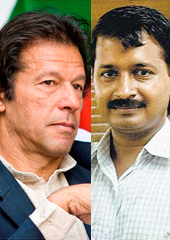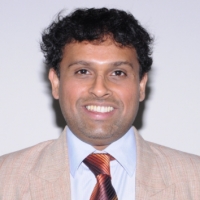India-Pakistan: What Impedes the Rise of Anti-Establishment Rebels?
What can Pakistan’s elections tell us about the coming fate of India’s reformers battling stifling corruption?
May 21, 2013

Politics can often seem immobile, a domain of established and deeply entrenched parties. Occasionally, the hope arises that new forces can change the landscape.
There were big hopes in Pakistan (via the former cricketer Imran Khan) — hopes that remain alive in India (via Arvind Kejriwal, a former civil servant) — that this year would be the moment for such history-makers.
But sadly for these anti-establishment rebels, the hurdles to their rises to power are daunting.
In Pakistan’s recent general election, Khan’s Pakistan Movement for Justice (PTI) underperformed expectations and came a distant third, way behind the traditional political machine of Nawaz Sharif’s Muslim League (PML-N).
That disappointing outcome offers a valuable lesson about the limits to change in societies that are not really ready for radical overhaul.
Khan campaigned ferociously against Pakistan’s feudal biradari (male extended clan) politics.
This system is based on vote-banks delivered by aristocratic landowners, the rooted culture of ‘electables’ (that is, hereditary “worthies” from socially and economically dominant sections) and claims of historical pedigree and experience in governing.
Khan, who attracted a great deal of media attention owing to his status as a former sports star), lampooned both Sharif and President Asif Ali Zardari’s Pakistan People’s Party (PPP).
He cast them as representatives of tiresome cloak-and-dagger politics that lack transparency and betray the public. On substance, he was of course right.
But unlike his legendary bowling that thrilled all Pakistani cricket fans, Khan’s clarion call to throw out hierarchical and centralized forms of politics essentially fell flat.
Why? Because he managed to win only the hearts (and mostly minds) of some young urbanites. That is a real handicap in a country where a majority of voters still reside in religious rural areas.
The pre-election hype surrounding Khan’s PTI was quite amazing. There were claims he was running “neck and neck” with Sharif’s PML-N. Even more astoundingly, his party was presumed to emerge as the single largest party after the elections.
In the end, all the hype was mostly a social media creation. Khan’s electoral appeal did not reach beyond the YouTube generation and the chic class, which is a minority in a conservative society like Pakistan.
Sharif, on the other hand, banked on classic welfare populism of his younger brother, Shahbaz Sharif. As the longtime Chief Minister of Punjab, by far Pakistan’s largest province, he generously distributed free laptop computers and solar home kits.
The wily Sharif brothers also successfully played the politics of the establishment. They carefully chose candidates based on their social position and status in particular election districts.
They succeeded precisely because they harnessed the existing status quo.
If Generation Y hates bowing to authority figures, Sharif decided that he could not ignore the established system. His overriding goal was to win enough votes to get back to power after 14 years in the wilderness.
Khan electrified urban college crowds with slogans of “naya Pakistan” (new Pakistan) and tabdeeli (transformation).
Sharif opted for a copybook formula of accommodating elite interests and sewing a winning combination based on shrewd reading of grassroots realities.
Ultimately, the same landed and industrial haves, who had monopolized Pakistani politics for decades, prevailed over the have-nots.
Khan would not even have managed to reach third place in the overall results of the Pakistani National Assembly if the Pakistani Taliban (TTP) had not terrorized the PPP and other secular parties into hiding, through violent attacks and assassinations.
It is worth noting that the Khan’s PTI won 17 out of its total of 29 seats from the province of Khyber Pakhtunkhwa, where the secular Awami National Party (ANP) had been pushed underground by the Taliban’s intolerance.
It is ironic that the same urbane Imran Khan, darling of the Twitterati, ended up in first place in national and provincial elections in that ultra-conservative province with abysmally low levels of literacy, due to peculiar local circumstances.
It’s all “thanks” to friendly fire from the Taliban.
Lessons for India’s reformers?
The average showing of Imran Khan in Pakistan’s National Assembly after all the high hopes and the media hoopla is an indicator of what awaits Arvind Kejriwal’s Common Man Party (AAP) in India’s next general elections.
His AAP has won plaudits from India’s English-speaking intelligentsia and frustrated urban middle classes for promising “revolution” against corrupt politicking of all established political parties.
But the party’s penetration of, and connection with India’s very complex, multilayered society is negligible.
The handicaps for such upstarts are big: They lack a mass base, don’t have a cadre immersed in rural communities and are often unwilling to play the ‘game of politics’ (by placating local bigwigs).
In addition, they don’t have a good grasp of the national pulse and psyche — which are distinct from the rage of the urban middle classes.
What they do offer — being a few steps ahead of society in terms of ideals and values — is a recipe for disappointment.
From outside the country, and even from the capital city, one may believe that the mere existence of a crisis-like environment in a country is sufficient to propel anti-politician and anti-systemic parties to succeed.
In all likelihood, though, this is entirely unrealistic. In particular, there must be a sounder social base for rejectionist parties to work their magic and take power.
Not just in Asia: Europe, too
That is true even in the extreme economic crisis-plagued eurozone.
There, quintessential outsiders like the Five Star movement in Italy (led by a comedian, Beppe Grillo) and Team Stronach in Austria (led by a maverick anti-euro billionaire Frank Stronach) have seen their fortunes rise somewhat.
But they have failed to go the full distance and win major elections or become decisive players.
Other fledgling protest parties with avant-garde identities, like the Pirate Party of Germany, have fallen by the wayside as well. The reason often is due to weak organizational dynamics after making splashy debuts.
In the big wheels of the real political process, it simply doesn’t suffice, as new political animals often like to do, to claimed that the ushering of ‘e-democracy’ will bring salvation and render mainstream parties obsolete.
The likes of Imran Khan and Arvind Kejriwal posit the existence of a polity in which there is direct democracy between the citizen and the state — and that the greedy intermediaries are non-existent.
This profoundly liberal belief runs into rough weather in non-individualistic and communitarian societies where group and identity still count. In such countries, any alternative political parties face a doubly difficult mission.
The Greens and South Asia
At the same time, not all hope is lost. Imran Khan has a realist side. That became apparent when he expressed admiration for the Chief Minister of Bihar, Nitish Kumar.
The latter swept aside decades of caste-based identity politics in one of the poorest and most lawless corners of India and has made good governance his signature style of new politics.
To be sure, Khan will have to learn from his Indian role model how to balance good governance logic with smart political maneuvering.
That means in a very pragmatic fashion catering to undeniable societal structures that may be somewhat unpleasant, anti-modern or otherwise distasteful. But they are the ones that matter on the ground — and at the ballot box.
The brief history of the Green Parties in Europe demonstrates that this is possible. As advocates of pro-environmental policies, they steadily moved from political fringe in the early 1980s to the center of government.
New modes of politics can eventually break through and even secure power. But for that to happen in Pakistan and India, Messrs. Khan and Kejriwal have to:
- undertake much broader mass mobilization efforts
- have a much longer time horizon
- consider prevailing social attitudes and outlooks, and
- develop a plan to let these mass views catch up with their currently still very iconoclastic visions in a realistic time frame.
Editor’s note: A earlier version of this analysis originally appeared in the Indian newspaper The Statesman.
Takeaways
Khan's appeal was limited to the YouTube generation and the chic class, a minority in conservative Pakistan.
Sharif banked on classic welfare populism and played the usual establishment politics.
The same haves who have run Pakistani politics for decades prevailed over the have-nots.
Pakistan's election is an indicator of what awaits the Common Man Party in India.
Winning praise from India's English-speaking intelligentsia for anti-corruption promises only goes so far.

